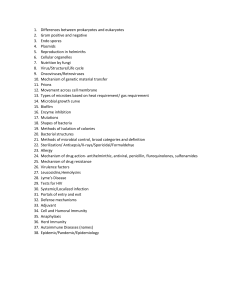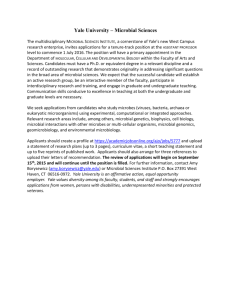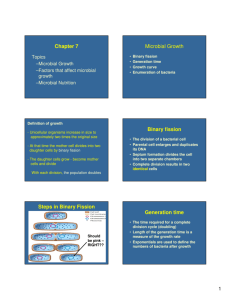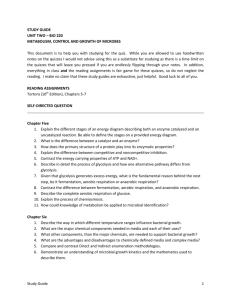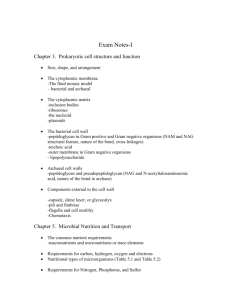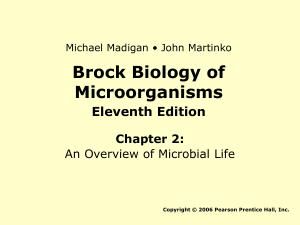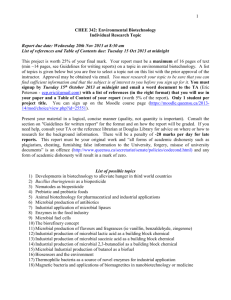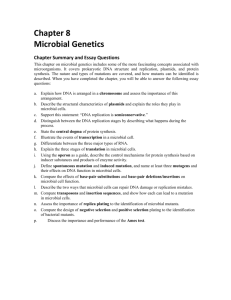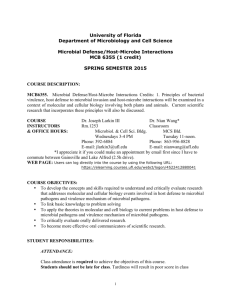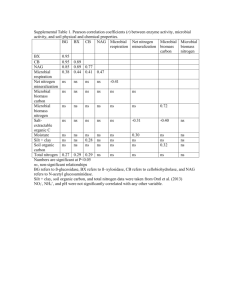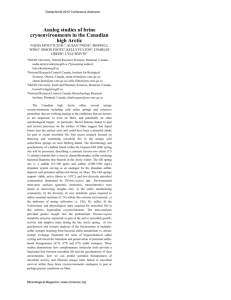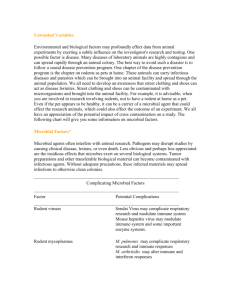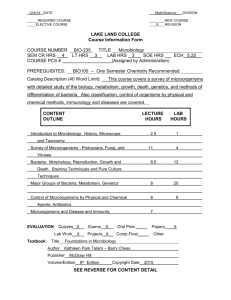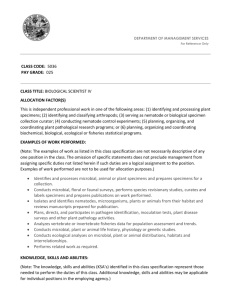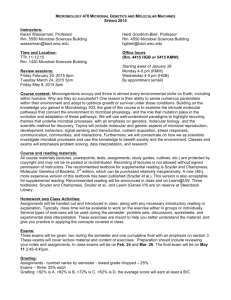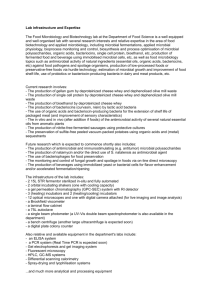MICR 201 F2010 Guide for Finals - Cal State LA
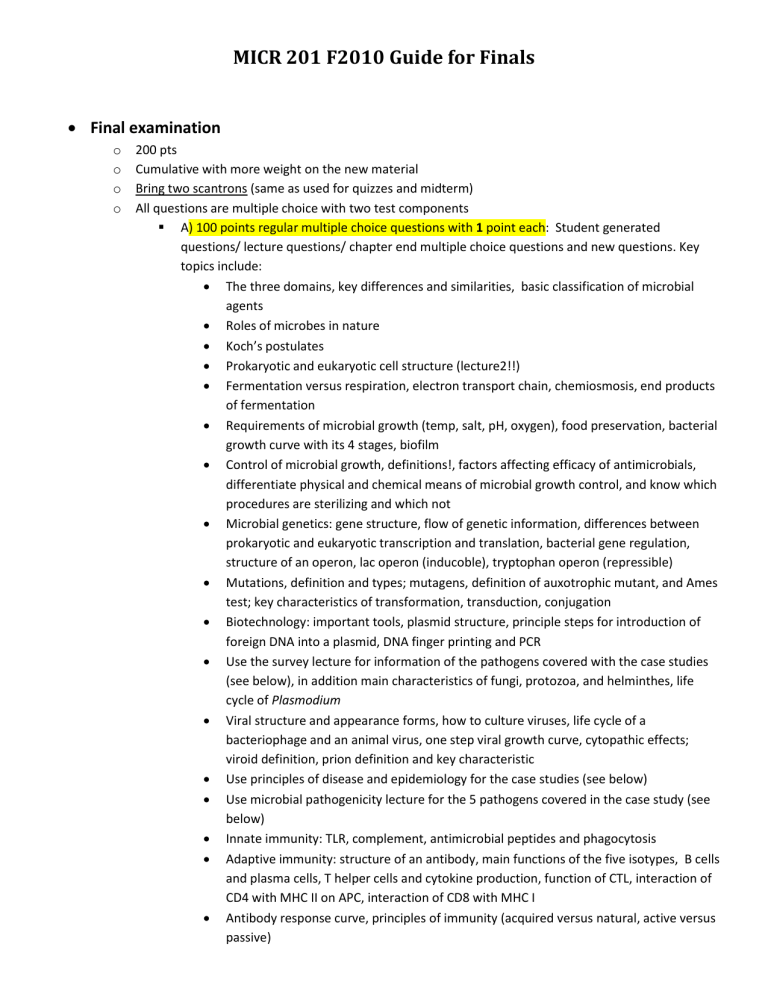
MICR 201 F2010 Guide for Finals
Final examination
o 200 pts o Cumulative with more weight on the new material o Bring two scantrons (same as used for quizzes and midterm) o All questions are multiple choice with two test components
A) 100 points regular multiple choice questions with 1 point each: Student generated questions/ lecture questions/ chapter end multiple choice questions and new questions. Key topics include:
The three domains, key differences and similarities, basic classification of microbial agents
Roles of microbes in nature
Koch’s postulates
Prokaryotic and eukaryotic cell structure (lecture2!!)
Fermentation versus respiration, electron transport chain, chemiosmosis, end products of fermentation
Requirements of microbial growth (temp, salt, pH, oxygen), food preservation, bacterial growth curve with its 4 stages, biofilm
Control of microbial growth, definitions!, factors affecting efficacy of antimicrobials, differentiate physical and chemical means of microbial growth control, and know which procedures are sterilizing and which not
Microbial genetics: gene structure, flow of genetic information, differences between prokaryotic and eukaryotic transcription and translation, bacterial gene regulation, structure of an operon, lac operon (inducoble), tryptophan operon (repressible)
Mutations, definition and types; mutagens, definition of auxotrophic mutant, and Ames test; key characteristics of transformation, transduction, conjugation
Biotechnology: important tools, plasmid structure, principle steps for introduction of foreign DNA into a plasmid, DNA finger printing and PCR
Use the survey lecture for information of the pathogens covered with the case studies
(see below), in addition main characteristics of fungi, protozoa, and helminthes, life cycle of Plasmodium
Viral structure and appearance forms, how to culture viruses, life cycle of a bacteriophage and an animal virus, one step viral growth curve, cytopathic effects; viroid definition, prion definition and key characteristic
Use principles of disease and epidemiology for the case studies (see below)
Use microbial pathogenicity lecture for the 5 pathogens covered in the case study (see below)
Innate immunity: TLR, complement, antimicrobial peptides and phagocytosis
Adaptive immunity: structure of an antibody, main functions of the five isotypes, B cells and plasma cells, T helper cells and cytokine production, function of CTL, interaction of
CD4 with MHC II on APC, interaction of CD8 with MHC I
Antibody response curve, principles of immunity (acquired versus natural, active versus passive)
Types of hypersensitivity reactions (summary slide), types of autoimmune diseases with examples, overview for types of immune deficiencies
For all infectious diseases know the key organisms and the types of infections they cause with their key symptoms.
Antibiotics and their targets, mechanism of bacterial resistance, know the names of antifungal agents and antiparasitic drugs, know the classes of antiviral agents
B) 100 points for 5 case studies with in total 50 questions, each 2 points worth. Possible case descriptions will be presented during lecture in the remaining sessions.
Pathogens covered: o MRSA (methicillin resistant Staphylococcus aureus) o Chlamydia trachomatis o HIV o Salmonella typhimurium o Mycobacterium tuberculosis
“Must knows” for each pathogen:
Morphology and basic description (e.g., gram positive cocci in clusters, facultative anaerobic, enveloped virus with 2 copies of single stranded RNA, etc)
Proliferation (e.g., extracellular organism -grows easily on agar media, facultative intracellular -can survive in macrophages e.g. or other cells or actually seeks hiding in host cells; obligate intracellular etc)
Is pathogen part of normal microbiota? (e.g., skin, nasooropharynx, etc)
How transmitted (e.g., aerosol, direct contact, foodborne, etc)
Main pathogenic factors (e.g., coagulase, hemolysin, lipid rich cell wall, etc)
How can it evade our host defense? (e.g. protein A for S. aureus, suppression of T cell function by HIV, etc)
Main symptoms of disease (e.g. diarrhea in Salmonella)
What is done for diagnostic (e.g. culture with agar plates; inoculation of eukaryotic cells to grow in the laboratory; nucleic acids or antibody detection such as done for HIV infections)
What drugs (if any) are used to combat the disease (e.g. vancomycin for MRSA, etc)
Final extra credit opportunity (10 pts)
o Interview a health care provider (nurse, physician assistant, physician, dentist etc) and ask (1) what in their experience the most common infectious diseases are, (2) what they think are the biggest threats among infectious diseases, and (3) what they think would be a solution. Write a 1 page report on this
(Times New Roman or Arial or Calibri font type, 12 pt font size, double spaced): make sure to clearly state whom you interviewed and at what institution/location; briefly summarize the responses and discuss whether this is in line with what you have learned so far or not. You must attach to the report some evidence that you actually interviewed this professional- e.g. a note on official stationary with signature. o Turn in at the beginning of the lecture final
